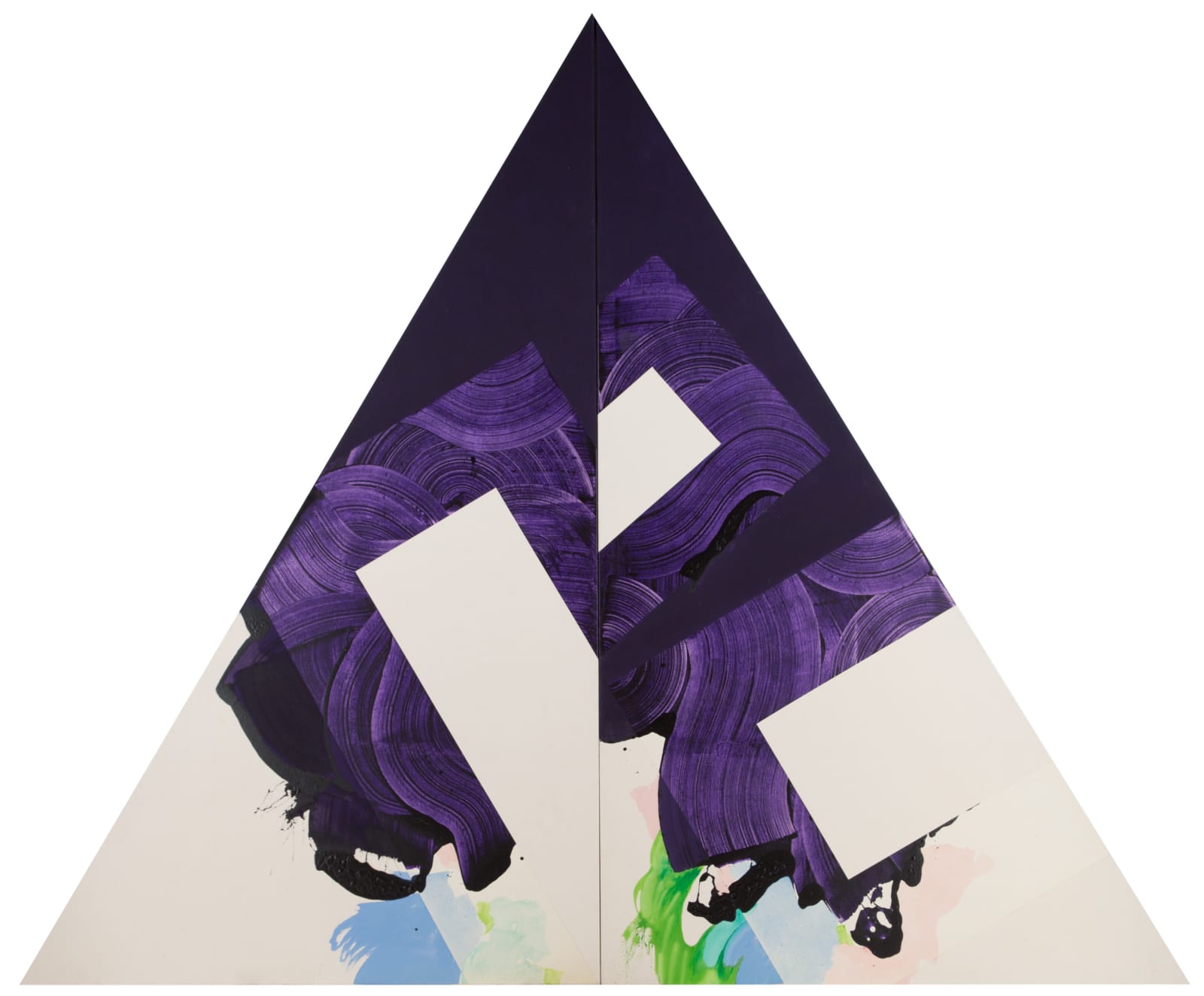



Robert Reed
Plum Nellie Split, November Reason, 1972
Acrylic on canvas
304.8 x 365.8 cm
120 x 144 in
120 x 144 in
Copyright The Artist
Further images
Articulated over a series of large canvases and smaller monotypes, drawings and collages, Robert Reed’s Plum Nellie works, made in the early ’70s, hold strict forms in playful counterpoint. In...
Articulated over a series of large canvases and smaller monotypes, drawings and collages, Robert Reed’s Plum Nellie works, made in the early ’70s, hold strict forms in playful counterpoint. In the imposing triangular painting Plum Nellie Split, November Reason #2 (1972), raw canvas is the grounds for a negotiation between hard-edged blank rectangles and roiling purple arcs. Arranged like posts and lintels, for all their geometric solidity, the rectangles are literally voids, portals for the canvas to body forth. They extend their presence across the surface through a subtle change of texture from matte to velvet, the ghost of a frame. When he began making the Plum Nellie works at the age of 31 in 1969, Reed was already associate professor of painting at the Yale School of Art, from which he had received his BFA in 1960 and MFA in 1962, and where he would continue to teach for nearly half a century until his passing in 2014. While he made the Plum Nellie works, he was also director of the Yale Summer School of Music and Art in Norfolk, CT, where he invited artists such as Philip Guston, Chuck Close, Sam Gilliam and Al Held to teach.
Reed’s work found early success in the New York art world, and after his inclusion in the Whitney’s 1972 “Annual Show” (the last before the Annual Shows were combined into the Whitney Biennial), he was invited to show seven large-scale Plum Nellie paintings in a solo show at the museum, “Robert Reed” (March 8—April 8, 1973). This was a crucial moment in the exhibition history of work by African American artists in established New York art institutions. Within the five years prior to Reed’s solo show, the Studio Museum opened its doors in Harlem, the Brooklyn Museum launched its Community Gallery (Reed’s work was included in a group show), and the Whitney itself put on the controversial exhibition “Contemporary Black Artists in America,” from which sixteen artists would withdraw their work in protest, just two years prior, in 1971.
In his split paintings, Reed worked these surface calibrations across the “gutter” between canvases as well. He has said he became interested in the triangle as “a very frontal plane, a very aggressive plane, but at the same time one that sat there and became very stable.” Working slowly, he poured deep dioxidine purple acrylic on canvas on the floor. He usually worked from the center out, forming organic squeegee-like marks which sunk into the cotton and transformed to luscious, velvety stain. Sometimes he scraped the surface. At one point it became clear to him that “the main character was always the violet,” he explained in a 1973 interview with Whitney curator Robert Doty, “and the violet began to be the thing around which everything was rallying.”[i] To Reed, purple was regal. And at the same time, it was intimately connected to early memories of his childhood in Charlottesville, Virginia. “Plum nellie” is an expression Reed heard growing up in the South, where he remembered older folks using it to mean “damn near.” As he told it in an interview years later, one day he was mixing colors for a painting, trying to think of a title, and began saying to himself, “Oh, it's not there yet. Not there. Plum nellie…”[ii]
Reed’s work found early success in the New York art world, and after his inclusion in the Whitney’s 1972 “Annual Show” (the last before the Annual Shows were combined into the Whitney Biennial), he was invited to show seven large-scale Plum Nellie paintings in a solo show at the museum, “Robert Reed” (March 8—April 8, 1973). This was a crucial moment in the exhibition history of work by African American artists in established New York art institutions. Within the five years prior to Reed’s solo show, the Studio Museum opened its doors in Harlem, the Brooklyn Museum launched its Community Gallery (Reed’s work was included in a group show), and the Whitney itself put on the controversial exhibition “Contemporary Black Artists in America,” from which sixteen artists would withdraw their work in protest, just two years prior, in 1971.
In his split paintings, Reed worked these surface calibrations across the “gutter” between canvases as well. He has said he became interested in the triangle as “a very frontal plane, a very aggressive plane, but at the same time one that sat there and became very stable.” Working slowly, he poured deep dioxidine purple acrylic on canvas on the floor. He usually worked from the center out, forming organic squeegee-like marks which sunk into the cotton and transformed to luscious, velvety stain. Sometimes he scraped the surface. At one point it became clear to him that “the main character was always the violet,” he explained in a 1973 interview with Whitney curator Robert Doty, “and the violet began to be the thing around which everything was rallying.”[i] To Reed, purple was regal. And at the same time, it was intimately connected to early memories of his childhood in Charlottesville, Virginia. “Plum nellie” is an expression Reed heard growing up in the South, where he remembered older folks using it to mean “damn near.” As he told it in an interview years later, one day he was mixing colors for a painting, trying to think of a title, and began saying to himself, “Oh, it's not there yet. Not there. Plum nellie…”[ii]
Exhibitions
Exhibited1973, Mar. "Robert Reed One Man Show", Whitney Museum of Modern Art, NY, NY



